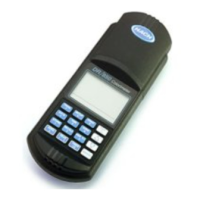95
6. Calculate the amount of Chlorine Solution to be added to the
ammonia standard using the following equation:
7. Turn the stir plate on to medium speed.
8. Open an ampule. Use a glass Mohr pipet to add the calculated
amount of Chlorine Solution slowly to the ammonia standard
while it is mixing.
9. Allow the monochloramine solution to mix for 1 minute after
all the Chlorine Solution is added.
10. Quantitatively transfer the monochloramine solution to a
clean 100-mL Class A volumetric flask. Dilute to the mark
with organic-free water. Cap and mix thoroughly. This is a
nominal 4.5-mg/L (as Cl
2
) monochloramine standard.
Use this solution within 1 hour of preparation.
Method Performance
Precision
In a single laboratory, using a standard solution of 3.5 mg/L
monochloramine as chlorine and two representative lots of
reagent, a single operator obtained a standard deviation of
±0.2mg/L Cl
2
.
Estimated Detection Limit
The estimated detection limit (EDL) for Method 10172 is 0.2 mg/
L Cl
2
. For more information on the EDL, see Section 1 of the DR/
800 Procedure Manual.
Interferences
The following have been tested for interference and found not to
interfere up to the indicated levels:
mL chlorine solution required
455
free chlorine concentration
----------------------------------------------------------------=
Table 11 Non-interfering Substances
Substance Maximum Level Tested
Alanine 1 mg/L N
Aluminum 10 mg/L
Bromide 100 mg/L Br
-
Bromine 15 mg/L Br
2
Calcium 1000 mg/L as CaCO
3
CHLORAMINE, MONO, High Range, continued

